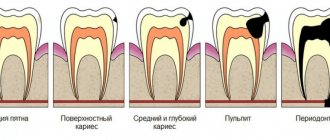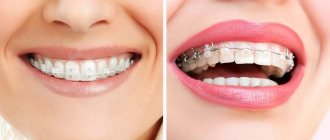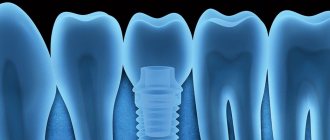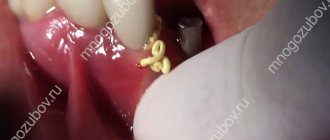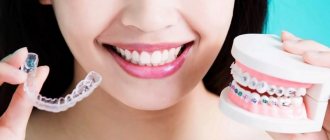Depulpation of a dental element is a procedure that allows you to kill a painful nerve that worries the patient. This manipulation requires the use of special painkillers, one of which is arsenic. To necrotize the dental nerve, arsenic paste is placed into the canal. To achieve the desired effect, the product must be kept for a certain time. Therefore, it is very important to know how much arsenic should be kept in the dental element.
Application in dentistry
Arsenic paste is used in the treatment of pulpitis for the purpose of analgesic effects on the pulp. However, in this case there are indications and contraindications.
Arsenic must be used:
- when a patient may have an allergic reaction to an anesthetic drug;
- if the anesthetic drug used does not have the maximum effect;
- there is not enough time for the anesthetic drug to take effect;
- if the patient has recently suffered a heart attack;
- the patient has hypertension;
- the patient is under the influence of alcohol.
Contraindications:
- when the patient has an allergic reaction to arsenic or anesthetic drugs that contain arsenic;
- if a child under three years old needs dental treatment;
- tooth roots are not sufficiently formed;
- if the patient is diagnosed with glaucoma;
- when the patient has pathologies of the genitourinary system;
- perforation of the roots of dental elements was diagnosed.
You can find out how treatment with arsenic works here:
Video - Specialist about arsenic in teeth
Characteristics of the drug
As a poison, arsenic has been known to mankind since time immemorial. For poisoning, they were given the death penalty: women were tortured and then drowned, and men were wheeled on the wheel. Even today, rats and mice are poisoned with this poison. A dosage of 5 g is considered dangerous for humans.
In dentistry, a paste based on arsenic anhydride is used. It also includes the following components:
- antiseptics for disinfecting the pulp and neutralizing the activity of pathogenic flora (Timol, Camphor);
- anesthetics (Lidocaine, Novocaine, etc.);
- astringents to prolong the action of the paste;
- various fillers.
The appearance of toothache indicates that the pathological process has spread to the soft tissues where the neurovascular bundle is localized. This is the final stage of the carious process. It is characterized by the development of pulpitis or periodontitis. In this case, the exposed nerve reacts to mechanical stimuli, excessively hot or cold food.
One of the common dental problems in children is gumboil. In official medicine such a term does not exist. They prefer to replace it with periostitis or purulent periostitis. Read more in the article: “Flux in a child - causes, symptoms and treatment.”
The cytotoxic properties of arsenic are used in dentistry to reduce the sensitivity of the neurovascular bundle. As a result of its use, the blood supply to the pulp is stopped. Necrosis occurs, which blocks the transmission of nerve impulses.
There are many ways to extract the dental nerve, but in practice only two of them are used:
- Extraction of pulp contents without devitalization of the neurovascular bundle. This method is used in emergency cases, but extremely rarely. During dental procedures, the doctor uses local anesthesia, while the living tissue of the tooth remains unharmed.
- Most often, the dentist opens the pulp contents and treats it with an arsenic-based paste. Devitalization of the neurovascular bundle occurs.
The choice of most doctors in favor of the second option is quite obvious. For dental procedures, safe dosages of arsenic are used, which does not harm the body. The toxin reliably anesthetizes, and the depulpation procedure takes place in comfortable conditions for the patient. No additional medications are required. The patient only needs to wait a while, after which the specialist will remove the nerve. However, sometimes after applying the paste with arsenic, the tooth begins to hurt very much.
Dentists are one of the few doctors whose visits patients prefer to postpone. Therefore, treatment of advanced caries is not uncommon. Read more in the article: “they put arsenic, but the tooth still hurts.”
Stages of treatment
The initiation of therapy must necessarily begin with an examination using an x-ray. Then, if the pathology is confirmed, the specialist opens the carious cavity and removes dead tissue. Arsenic paste is placed into the cleaned channel. The final steps include filling the dental element with a temporary filling. The doctor determines the duration of arsenic exposure. The second visit is characterized by the removal of arsenic from the tooth and the dead nerve is removed. This manipulation is absolutely painless.
First aid
To relieve pain, you must take any non-steroidal anti-inflammatory drug. The most popular are Diclofenac, Ibuprofen and Nurofen. They not only have an analgesic effect, but also have an anti-inflammatory and pronounced antipyretic effect. If there are none in your home medicine cabinet, you can drink regular Analgin. Any pills should be taken only after reading the instructions and studying possible contraindications.
It is not recommended to self-medicate and try recipes from traditional healers. Do not apply dry heat to the affected area. If the pain cannot be tolerated and a visit to the dentist is postponed, you should try to extract the arsenic paste yourself. Just follow the steps below:
- First you need to prepare a regular needle, first rinse it with any disinfectant.
- Then you need to brush your teeth with toothpaste and rinse your mouth well.
- If the temporary filling has not yet fallen out on its own at this stage, it can be picked out with a needle. It is important not to touch the soft gum tissue.
- A small gray ball will be easily visible under the filling. You need to carefully pry the paste ball with a needle and try to pull it out.
- After all manipulations, rinsing with a decoction of chamomile or soda is recommended. You can add a small amount of peroxide to the liquid.
- At the final stage, the open tooth cavity should be closed with a cotton swab.
After all the manipulations, it is important to contact the dentist as soon as possible. An open dental canal is an easy way for any infection to enter. Before visiting a doctor, you should try not to eat or drink.
How long should you keep arsenic paste in your tooth?
It is very important to determine how much arsenic should be kept. There are a lot of criteria here - the patient’s age, the drug used, pulp indicators (the drug is placed on a closed pulp or an open one). The average duration of exposure to arsenic on a nerve is 1 day. If multiple treatments are necessary, the doctor will increase the duration of action to two days.
If we are talking about the treatment of dental elements of children, then the extraction of arsenic should occur no later than 16 hours later.
Attention! There are modern medicines that contain arsenic. Their effect on the diseased nerve can be increased to five days.
Possible problems and complications
The occurrence of local and general complications due to necrotization of dental nervous tissue by arsenic salts is a fairly rare occurrence. A new inflammatory process occurs when the dentist’s work is insufficiently high-quality and qualified, arsenic is not deposited correctly, or the canals of the treated tooth are incompletely sealed and cleaned.
The tooth still hurts
After the medicine is administered, there is a chance that the tooth will hurt. If even after a day the pain does not subside, but intensifies, takes on a sharp “tugging” character, and swelling of the gums increases, this may mean that the dentist made a mistake and placed the paste above the pulp. In this case, arsenic does not come into contact with the nerve endings, and inflammation continues to develop. You should immediately contact your doctor to correct the error.
Tooth hurts after arsenic is removed
After removing arsenic from a diseased tooth and cleaning the canals from dead tissue, the filling stage follows. After some time, the tooth may begin to ache and ache again, which indicates that the dentist’s work is not of sufficient quality.
The problem may arise due to incomplete extraction of the remains of the nerve, which rot and become inflamed under the filling; the process captures the gum tissue (see also: how and with what can you kill the dental nerve at home?). Sometimes the canals are not completely filled, then inflammation is caused by the remains of microorganisms in the cavities. It happens that the dentist leaves a piece of the instrument in the canal. This situation requires a mandatory re-visit to a specialist, opening and cleaning of the canals.
Recommendations
Since arsenic paste is poisonous, safety rules must be followed. It is important to come to your next appointment at the time agreed with your doctor. First of all, follow this list of rules:
- Maintain the integrity of the temporary filling. Initially, the filling is made airtight, so arsenic acts exclusively on the diseased nerve. If the integrity of the filling is damaged, arsenic comes out and affects the surrounding tissues. As a result, an inflammatory process occurs, which is accompanied by painful sensations.
- Do not exceed the period of exposure to arsenic.
- The specialist should not make a mistake with the dosage of the product.
What to do if you experience discomfort?
Often the patient may experience discomfort when exposed to arsenic, to minimize anxiety, it is recommended:
- rinse your mouth with soda solution if there is a sour taste. In this way, the acidic effect can be neutralized and burns can be avoided;
- after arsenic is introduced into the tooth, pain may occur; a glass of warm milk will be required to relieve it. To do this, hold the milk in your mouth for a few seconds, and then drink the drink completely.
Reference! Milk, namely the protein it contains, quickly removes arsenic from the body.
How does it affect the nerve?
When an arsenic compound interacts with living cells, it quickly penetrates through the cell membrane into the cytoplasm, where it interferes with aerobic oxidation processes in the mitochondrial apparatus. Violation of the absorption of oxygen atoms by the cell leads to its death, thus devitalization of the pulp occurs.
When all nerve cells die, pain is eliminated, and tissue swelling gradually subsides. Necrotic tissue remains in the tooth pulp and is then removed by the dentist.
How harmful is arsenic?
Since this product is a type of poison, it is used for dental purposes in minimal dosages, with strict adherence to safety rules. Proper use of arsenic minimizes harmful effects.
If the timing of exposure to arsenic is violated, it can penetrate the tissue structure, accumulate there and cause complications. If some of the arsenic gets into the oral cavity, then a protracted inflammatory process should be expected.
With incorrect dosages of arsenic, the following consequences are observed:
- Dentin begins to turn black.
- Swelling and inflammation of the pulp occurs.
- Toxic effects on the body.
- Inflammatory process of periodontal tissue.
- Osteonecrosis.
Very often, the patient may ignore the deadlines indicated by the specialist. As a result, arsenic periodontitis occurs, the treatment of which requires a long time. When exposed to arsenic, tissue necrosis cannot be ruled out. If the patient experiences increased sensitivity, toxic damage to the intestines and liver subsequently occurs.
Video - Treatment of pulpitis
What happens if you hold it for too long?
Arsenic is practically not used for depulpation in pregnant women and children
Since the substance is aggressive and toxic, with prolonged use it will not only deaden the nerve, but also begin to kill healthy tissue - teeth, roots, gums.
The same applies to neighboring areas. If you keep arsenic for too long, there is a risk of:
- Poisoning of the body, disruption of the digestive system and liver.
- Periodontal inflammation.
- Gum death.
Arsenic extraction process
In the depulpation procedure, it is very important to remove arsenic in a timely manner. If you ignore this indicator, you can get the above complications.
Advice! When the patient is unable to visit the doctor at the appointed time, the arsenic must be extracted independently. To do this, wash your hands and disinfect them in advance. Then break the integrity of the seal and remove the arsenic. The danger of manipulation is that it can be swallowed. Therefore, procedures should be carried out with extreme caution. Upon completion of the manipulation, the oral cavity must be rinsed with a soda solution. In this case, visit the dentist as soon as possible.
Indications for depulpation
When should a dental nerve be removed?
- Advanced caries;
- Pulpitis – including asymptomatic;
- Severe tooth trauma – partial destruction of the tooth and exposure of the nerve;
- Preparation for prosthetic crowns (at the discretion of the orthopedic dentist);
- Periodontitis;
- Consequences of unsuccessful treatment;
- Unbearable pain.
Use of arsenic for pregnant women
If a woman is a nursing mother or is pregnant, then the use of products containing arsenic is strictly prohibited. This is due to the toxic effect on the baby. When a woman is short of pregnancy, it is important to warn the dentist about the situation. Modern dentistry is rich in safer medications that are approved for use by pregnant women.
Contraindications
The following conditions are contraindications for the use of arsenic-based drugs:
- children's age up to 1.5 years;
- allergy to arsenic and its components;
- lack of fully formed roots or reabsorbing roots;
- when it is impossible to completely clean the canals (their curvature, fusion, blocking with tartar);
- artificial hole in the root (disconnection or perforation);
- high eye pressure (threat of glaucoma);
- not completely sanitized and cleaned channels;
- diseases of the urinary organs;
- state of pregnancy or breastfeeding.
The use of arsenic paste is not allowed for pregnant women and nursing mothers. In these situations, even the minimum content of poison can be unpredictable and toxic for the child’s body.
The use of arsenic is also undesirable for children. They often break the temporary filling themselves, and the toxic medicine enters the body. This can cause intoxication of the delicate child's body.
Arsenic is still commonly used by dentists. And its use can be very justified. An experienced doctor using this medicine has successfully relieved hundreds of patients from unbearable pain. The main thing is to cure the tooth without unnecessary suffering and not spoil your health. Take care of yourself and smile more often!
Sources used:
- Knizhnikov V.A., Bochkarev V.V., Zimina L.N., Marchenko E.N., Rubtsov A.F., Serebryakov L.A. Arsenic // Big Medical Encyclopedia
- Anesthesia in dentistry / S.F. Gritsuk. - M.: Medical Information Agency (MIA), 1998.
- Therapeutic dentistry. National leadership / L.A. Dmitrieva. - M.: GEOTAR-Media, 2015.
About the composition of arsenic paste
| Constituent component | Percentage % |
| Tannin | 1 |
| Antiseptic | 5 |
| Painkiller | 30 |
| Arsenous acid | 35 |
It is important! Additionally, auxiliary substances can be added to the paste, which are necessary for preparing a small dose.
The patient must remember that in no case should the duration of exposure to arsenic on the diseased nerve be exceeded, because this is fraught with dangerous consequences.
